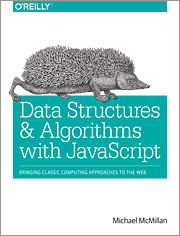review: Data Structures and Algorithms with JavaScript
¶ by Rob Friesel Mike McMillan’s Data Structures and Algorithms with JavaScript (O’Reilly, 2014) uses JavaScript as a vehicle for introducing a number of fundamental computer science concepts. It reminds me a little bit of Tom Stuart’s Understanding Computation 1 — that is, it’s a book about CS topics that targets people without a CS background. One might consider both books to be a gentle introduction to computer science, or “computer science for the layperson”. 2 Continue reading →
Mike McMillan’s Data Structures and Algorithms with JavaScript (O’Reilly, 2014) uses JavaScript as a vehicle for introducing a number of fundamental computer science concepts. It reminds me a little bit of Tom Stuart’s Understanding Computation 1 — that is, it’s a book about CS topics that targets people without a CS background. One might consider both books to be a gentle introduction to computer science, or “computer science for the layperson”. 2 Continue reading →
- I reviewed Understanding Computation last year. It was the first book that helped me to really understand the differences between “computer science” and “software engineering”.[↩]
- As condescending as it sounds, there were a couple of times where I thought a good subtitle for it might have been something like “A Field Guide to Real World Computer Science”.[↩]

